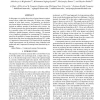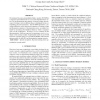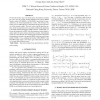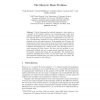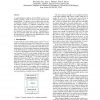131
Voted
ICASSP
2011
IEEE
14 years 4 months ago
2011
IEEE
In this paper, we explore the notion of using frames to project sensed colors within their inherently 3D space onto a larger number of color basis vectors. In particular, we devel...
103
Voted
ICASSP
2011
IEEE
14 years 4 months ago
2011
IEEE
We introduce Bayesian sensing hidden Markov models (BS-HMMs) to represent speech data based on a set of state-dependent basis vectors. By incorporating the prior density of sensin...
105
Voted
ICASSP
2011
IEEE
14 years 4 months ago
2011
IEEE
We describe feature space and model space discriminative training for a new class of acoustic models called Bayesian sensing hidden Markov models (BS-HMMs). In BS-HMMs, speech dat...
128
click to vote
TNN
2010
14 years 7 months ago
2010
Abstract--Recently, sparse approximation has become a preferred method for learning large scale kernel machines. This technique attempts to represent the solution with only a subse...
106
click to vote
TKDE
2008
15 years 15 days ago
2008
Matrix decomposition methods represent a data matrix as a product of two smaller matrices: one containing basis vectors that represent meaningful concepts in the data, and another ...
IVC
2008
15 years 17 days ago
2008
A new method to fit specific types of conics to scattered data points is introduced. Direct, specific fitting of ellipses and hyperbolae is achieved by imposing a quadratic constr...
95
Voted
ESANN
2006
15 years 2 months ago
2006
We propose an efficient forward regression algorithm based on greedy optimization of marginal likelihood. It can be understood as a forward selection procedure which adds a new bas...
111
click to vote
ICA
2007
Springer
15 years 2 months ago
2007
Springer
In this paper, we propose a Bayesian estimation approach to extend independent subspace analysis (ISA) for an overcomplete representation without imposing the orthogonal constraint...
118
Voted
ANTS
2010
Springer
15 years 4 months ago
2010
Springer
Lattices over number
elds arise from a variety of sources in algorithmic algebra and more recently cryptography. Similar to the classical case of Z-lattices, the choice of a nice,...
94
Voted
ETS
2006
IEEE
15 years 6 months ago
2006
IEEE
A central problem in built-in self test (BIST) is how to efficiently generate a small set of test vectors that detect all targeted faults. We propose a novel solution that uses l...
